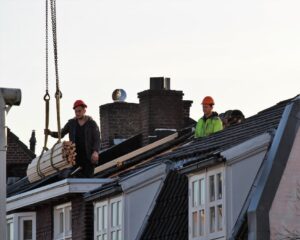Proper Roof Design, Installation, and Inspection in NJ
The roof is a critical part of the building envelope. It protects the structure against the elements that would otherwise damage the building’s structural framing components. . It also has a role in the overall structural strength of the entire building.
More than complementing the property’s overall aesthetic, the roof design protects the building against the normal weather conditions of the region. For example, coastal homes will benefit from a four-sided hip roof as it can more effectively withstand strong winds and liftoff.
Materials and component attachment are other significant factors affecting the building’s energy efficiency, durability, performance, and future maintenance needs. The shingles or membrane, sheathing, flashing, and underlayment must all be properly attached to avoid issues like wind damage, leaks, and mold. The roof system can deteriorate faster than expected with improper design and installation.
Types of Roof Design
A roof design gives a home or commercial establishment its personality. But how the peaks and valleys come together affects more than the property’s overall look. Roof designs each have their functions, some of which are better suited to particular weather patterns and architectural styles.
● Gable Roof
A Gable roof, commonly referred to as a pitched or peaked roof, is one of the most common roof styles in the US. They have a straightforward design that makes them simple and less expensive to construct. They can be covered with nearly any roofing material, including metal, clay tiles, composite shingles, or asphalt shingles.
Gable roofs provide more floor space for a loft or attic because of their triangle pitch. They are excellent for locations with a lot of rain or snow because they easily shed water. Gable roofs are not recommended for places subject to very high winds since they run the risk of collapsing if they are not properly designed and constructed with adequate framing supports and anchors.
- Hip Roof
Hip roofs feature equal-length slopes on all four sides that slope toward the walls. These roofs come in various styles, including basic hip, pyramid hip, cross-hipped, and half-hipped.
Hip roofs are fantastic for areas with a lot of rain, snow, and wind because they are sturdy. However, because of their intricate design, hip roofs typically cost more to construct because they require more roofing materials. Proper waterproofing is particularly crucial with hip roofs because of where the roof angles meet.
- Flat Roof
Flat roofs can give a house a contemporary appearance. Contrary to what their name suggests, flat roofs have a modest slope to help drain water. Due to their low pitch, flat roofs do not take up much room, so they can cover more outdoor living areas from the sun.
Flat roofs are not the best choice for regions with heavy rain or snowfall because, despite having a little slope for water drainage, they are more prone to water leaks. It is crucial to select continuous roofing materials without seams to keep flat roofs watertight. Gravel, roll roofing, metal sheets, PVC, TPO, and rubber are the most typical roofing materials used on flat roofs.
- Shed Roof
Shed roofs, also known as skillion roofs, differ from most roofs in that they are only pitched in one direction. This roof design is easier to frame and install than flat roofs because they need fewer building materials. For instance, it does not require roofing membranes because of their steep gradient.
Since shed roofs only have one side that drains the water, the design makes it simple to collect and store rainwater for a more sustainable lifestyle. However, shed roofs allow for less attic space, and because of the steep pitch, it risks having low ceilings on one side of the structure.
Installation
Standards like the 2018 International Building Code guide the proper design and installation of roof systems. Following roof attachment and installation requirements are critical to prevent blow-offs and membrane strain due to the components’ differential movement. The correct attachment will also deter damage from the elements, especially from wind force. Working with a qualified professional like a commercial building engineer NJ will provide the correct roof design and attachment of the roof system components.
Requirements for roof decks, minimum slopes, fasteners, attachments, and flashing depend on the material used.
● Asphalt Shingles
Asphalt shingles must be mounted on solidly sheathed decks. They must be fastened by galvanized stainless steel, copper, or aluminum roofing nails with a minimum 12-gauge shank and ⅜ inch diameter head. The fastener must be long enough to penetrate at least ¾ inch of the sheathing. The minimum number of fasteners will depend upon the manufacturer’s specifications, but it shall not be less than four per strip shingle or two for every individual shingle.
● Metal Roof Panel
Except when the roof covering is specifically made to be applied on spaced supports, metal roof panels must be applied to a solid or closely fitted deck. The minimum slope for a standing-seam metal roof panel system is a quarter unit vertical in 12 units horizontal (2% slope).
Stainless steel fasteners can be used for any type of metal roof. But galvanized nails are recommended for steel roofs, and aluminum fasteners are ideal for aluminum roofs.
● Clay and Concrete Tile
Clay and concrete tiles must be installed over solid or spaced structural sheathing boards. They must be applied to roof slopes equal to or greater than two and a half units vertical in 12 units vertical (12% slope). A double underlayment application is needed for roofs attached on a 21% to 33% sloped deck.
For clay and tile concrete, fasteners must be corrosion-resistant and less than 11 gauge and ⅚ inch head. The nail must be of sufficient length to penetrate through the deck’s thickness or at no less than ¾ inch of the deck, whichever is lower.
Weather Protection
Buildings can sustain damage in various ways if the roof system’s design is not weather-proofed. This includes total or partial roof displacement (blow-off), damage to penetrations (skylights, ducts, or vents), and damage to doors and windows.
These worries can be eliminated with proper design and attachment calculations. For example, adding a two-foot-tall or higher parapet wall can stop air from flowing over the structure. This prevents vortices from forming and lessens wind uplift.
Moreover, flashing must be installed in a certain way to prevent water from penetrating the wall through joints in copings, moisture-permeable materials, and intersections with parapet walls. Where secondary (emergency overflow) roof drains are necessary for secure drainage, they must be installed so that water will be held if the primary drains fail.
Roof Inspection in New Jersey
Leaks and drafts are the two obvious indications that the roof needs a residential or commercial building inspection NJ. Delaying this work could lead to small issues growing into major problems.
Contrary to popular belief, routine inspections of a roof can result in both cost savings and financial gains. It improves the chances of identifying roofing issues and prevents the need for costly repairs or replacement. It also keeps the building safer and more appealing if the owner decides to sell.
Roof inspections should only be performed by a qualified building inspection engineer NJ. A trained professional will know how to spot problems like rust, damaged seams or shingles, clogged gutters, and compromised flashing. They will examine visible roof sections and determine the soundness of the roof system.
Contact Lockatong Engineering to arrange a consultation or roof inspection with an experienced residential and commercial building inspector NJ.








